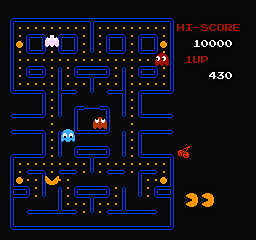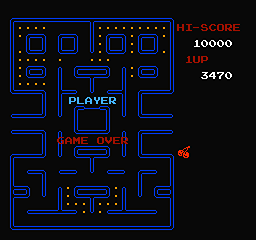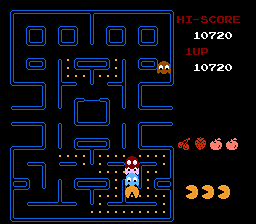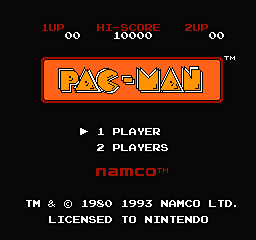
Pac-Man (1988-)
Developer: Namco
Publisher: Namco
Genre: Maze
Pac-Man for the NES was developed by Namco and released in 1988, following the massive success of the original arcade game of the same name. It was published by Namco in Japan and by Midway in North America, bringing the iconic maze-chase gameplay from arcades into the home console market. The NES version sought to replicate the experience of navigating mazes, avoiding ghosts, and collecting pellets, while adapting the graphics and controls to the limitations of home hardware. Pac-Man had already established itself as a cultural phenomenon, making this NES adaptation highly anticipated.
In the game, players control Pac-Man, a yellow circular character, as he moves through a series of mazes consuming all pellets while avoiding four roaming ghosts. Clearing each maze allows progression to the next level, with difficulty increasing as ghost AI becomes more challenging. The game’s inspiration comes directly from the arcade original, itself inspired by simple maze puzzles and the goal of creating a universally appealing, easy-to-learn but hard-to-master action game. The NES version also included minor enhancements and adjustments to keep gameplay fresh for home audiences.
Gameplay emphasizes pattern recognition, timing, and quick reflexes. Power pellets allow Pac-Man to temporarily turn the tables and eat the ghosts for bonus points, adding strategic depth to movement decisions. The NES adaptation includes multiple levels with slightly varied mazes and increasing speed of both Pac-Man and the ghosts, requiring players to adapt and plan their routes efficiently. While simplified compared to the arcade version, the NES control scheme and collision detection were faithful enough to maintain the original challenge and fun.
The soundtrack features catchy and upbeat background music and sound effects that punctuate eating pellets, consuming ghosts, and completing levels, enhancing the game’s energetic pace. Pac-Man spawned numerous sequels and spin-offs, including Ms. Pac-Man and Pac-Man Plus, expanding the franchise across consoles and arcade cabinets. Promotion relied on the arcade game’s fame, magazine advertising, and word-of-mouth acclaim, and reception was largely positive. Critics praised its faithful adaptation of the arcade gameplay, its colorful presentation, and its enduring appeal as a fun, accessible action title for the NES library.
Images from MobyGames
Buy Pac-Man
Click one of the Ebay or Amazon buttons below to check the latest prices and purchase Pac-Man for the Nintendo Entertainment System.

Related Searches
Pac-Man NES Download
Pac-Man is available to purchase and download from a range of vendors. Always shop around...
Pac-Man NES Manual
Various repositories around the internet have scanned and archived a range of retro manuals. Search now to.....
Pac-Man NES Rom
We don't host or link to rom sites for this game. However, there are many sites out there that may be...
Pac-Man NES Walkthrough
Many sites - particularly YouTube - host a range of walkthrough videos to guide you in your quest to get...
Pac-Man NES Cheats
There are various sites out there that can offer cheat codes for games. Search now to find all available...
Pac-Man NES Controls
This information can often be obtained through the user manual. Alternatively there are many sites out there...
Pac-Man NES Release Date
The initial release date for Pac-Man is stated as October 1988. Other ports of the game may..
Pac-Man NES Review
There are many sites out there that have collated and documented historic reviews of this game. Search now...
Pac-Man Famicom
As a Nintendo Entertainment System release, this game was also likely also available on the Famicom. This....
Pac-Man NES Speedrun
There is now a community of competitive speedrunners who will try and gain the fastest possible time on their....








